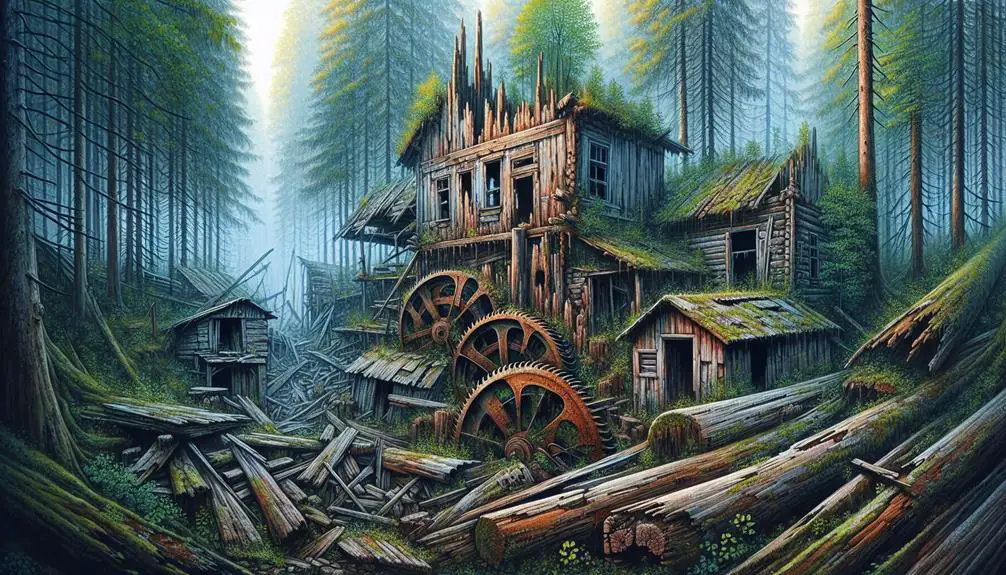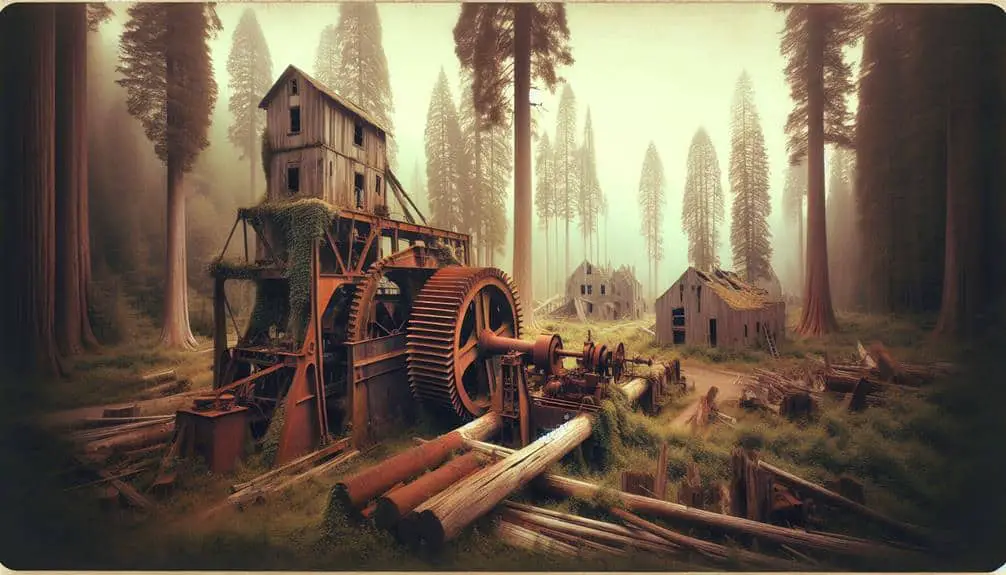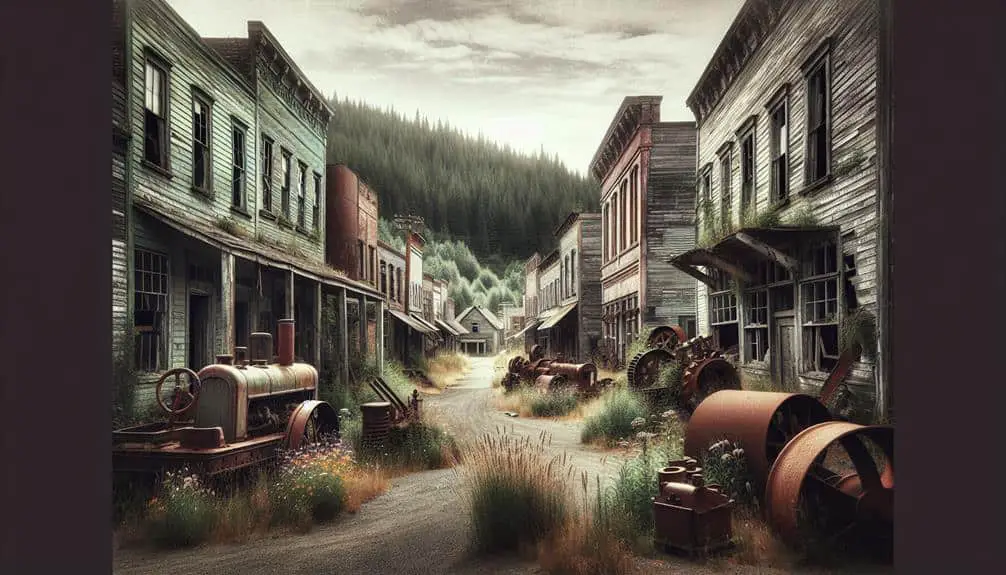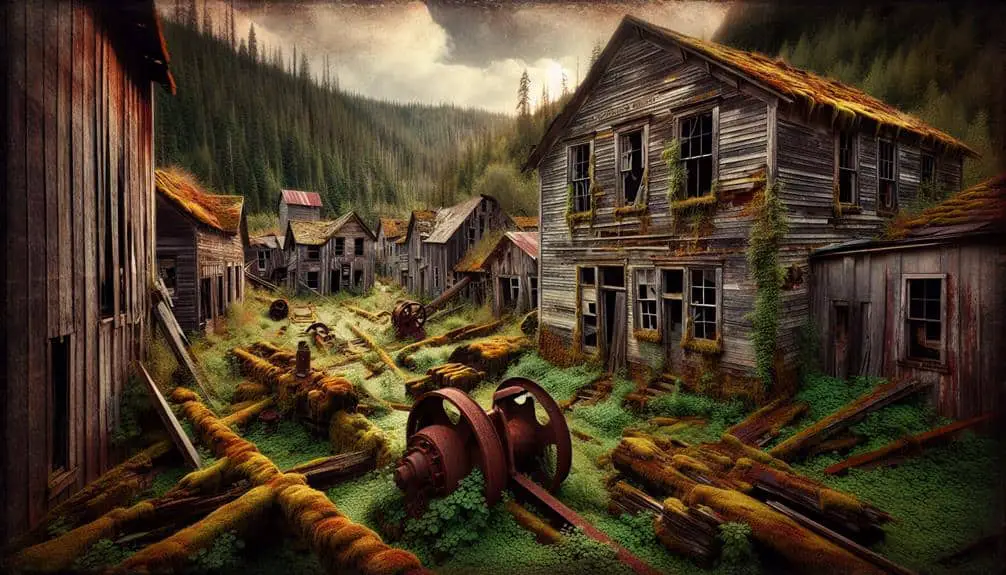Explore haunting remnants of logging era ghost towns. Abandoned sawmills and residences reveal stories of a once vibrant industry. Forgotten communities echo with tales of bygone livelihoods. Decay threatens historical significance, urging preservation efforts. Haunting stories of apparitions and lost traditions add a supernatural layer to these desolate places. Discover the rich history and eerie charm that these ghost towns hold, a confirmation to a legacy that still whispers secrets of the past.
Key Points
- Weathered structures and abandoned sawmills evoke historical charm and stories.
- Skeletal remains of once-thriving communities whisper tales of a bygone era.
- Preservation efforts combat decay to protect historical significance.
- Haunting stories and eerie artifacts linger in logging ghost towns.
- Legacy of logging industry's impact reflected in remnants of deforestation.
Rise and Fall of Logging Towns
During the late 19th and early 20th centuries, logging towns thrived across the American frontier before succumbing to rapid decline and abandonment. These towns were once bustling hubs of economic activity, driven by the booming timber industry. The economic impact of logging towns was significant, providing jobs for many individuals who sought opportunities in the expanding wilderness.
As the logging industry grew, so did the environmental legacy left behind by these towns. The widespread deforestation and disruption of natural habitats were unavoidable consequences of the rapid expansion. Rivers were dammed, forests cleared, and wildlife displaced, all in the name of progress and profit. The environmental footprint of these logging towns serves as a reminder of the delicate balance between economic development and ecological preservation.
Despite their eventual decline and abandonment, the legacy of these logging towns lives on, reminding us of the intertwined nature of economic growth and environmental stewardship. The rise and fall of these settlements serve as cautionary tales, urging us to contemplate the long-term consequences of our actions on both the economy and the environment.
Abandoned Sawmills and Residences
The remnants of abandoned sawmills and residences scattered throughout former logging towns stand as silent witnesses to a bygone era of bustling activity and economic prosperity. These structures, weathered by time and neglect, exude a rustic charm that captivates visitors with their history and the stories they hold within their decaying walls. As you wander through these abandoned sites, you can't help but feel a sense of awe at the craftsmanship and dedication that once thrived in these now-desolate places.
Each creaking floorboard and peeling wallpaper tells a tale of families who once called these places home, of workers who toiled in the sawmills to support their livelihoods. The echoes of laughter and the sound of saw blades slicing through timber are now replaced by an eerie silence that envelops these lost heritage sites.
Exploring these abandoned sawmills and residences offers a glimpse into a past where communities flourished, and the lumber industry reigned supreme. It's a poignant reminder of the transient nature of prosperity and the importance of preserving our history for future generations to appreciate.
Forgotten Lumber Industry Communities
Explore the forgotten lumber industry communities, where the echoes of a once-thriving livelihood now whisper tales of a bygone era. In these secluded enclaves, remnants of the logging industry's heyday linger amidst nature's reclamation. These forgotten communities, once bustling with the sounds of sawmills and the chatter of laborers, now stand as silent tributes to a faded chapter of history. Walking through these ghostly towns, you can almost feel the presence of those who toiled in the logging industry, their stories etched into the weathered facades of abandoned buildings.
The logging industry shaped the identities of these communities, providing sustenance and purpose to generations of residents. Now, only the skeletal remains of structures and overgrown pathways bear witness to the industry's former glory. The forgotten communities serve as poignant reminders of the transient nature of livelihoods and the enduring resilience of nature. As you wander through these forgotten lumber industry communities, take a moment to reflect on the legacy left behind by those who once called these places home.
Decay and Preservation Efforts
Decay silently creeps through the abandoned structures of these lumber industry communities, prompting dedicated preservation efforts to safeguard their historical significance. As time passes, the once bustling towns that thrived on the timber industry now face preservation challenges due to neglect and natural deterioration. The battle against decay is a race against time, with each passing year posing a threat to the integrity of these historical sites.
Preservation efforts often involve a delicate balance between maintaining the authenticity of the ghost towns and ensuring their structural stability. Historical importance plays a vital role in guiding these endeavors, as each building, street, and artifact holds a piece of the past waiting to be preserved for future generations.
The challenges faced in preserving logging era ghost towns are multifaceted, requiring a combination of funding, expertise, and community involvement. Despite the obstacles, the commitment to protecting these remnants of a bygone era remains strong, driven by the desire to honor the legacy of those who once called these towns home.
Haunting Stories of Logging Ghost Towns
As history whispers from the weathered walls, haunting tales emerge from the shadows of logging ghost towns, weaving a tapestry of bygone lives and eerie remnants. Exploring these abandoned settlements, you might encounter chilling stories that linger in the air like a ghostly presence, reminding you of the mysteries that shroud these forgotten places.
- Supernatural Encounters: Locals speak of apparitions wandering the empty streets at night, their presence sending shivers down the spine.
- Lost Traditions: In the silence of these ghost towns, echoes of once-vibrant traditions can still be faintly heard, hinting at the lives that were lived here long ago.
- Whispers in the Wind: Visitors have reported hearing disembodied whispers carried on the breeze, as if the spirits of the past were trying to communicate.
- Shadowy Figures: Some have seen fleeting glimpses of shadowy figures out of the corner of their eye, only for them to vanish when approached.
- Eerie Artifacts: Among the decaying buildings, eerie artifacts from a bygone era can be found, each telling a silent story of what once was.
Frequently Asked Questions
How Did the Decline of the Logging Industry Impact the Local Economy and Population of These Ghost Towns?
When the logging industry declined, ghost towns experienced a sharp impact. The local economy suffered, leading to population decline and abandoned buildings. Economic struggles were evident as the once-thriving community dwindled, leaving behind remnants of a forgotten era.
What Are Some Common Artifacts or Remnants That Can Still Be Found in These Abandoned Sawmills and Residences?
As you explore abandoned sawmills and residences, you'll come across industrial artifacts like rusted logging equipment and architectural remnants such as decaying structures. Personal belongings left behind offer glimpses into the lives of those who once inhabited these spaces.
Are There Any Unique Cultural or Historical Aspects of the Lumber Industry Communities That Have Been Preserved or Documented?
Explore the unique cultural preservation and historical documentation of lumber industry communities. Discover their rich heritage through artifacts, stories, and structures that offer a glimpse into the past. Uncover the legacy that remains alive today.
How Do Local Preservation Efforts Work to Maintain and Protect the Decaying Structures in These Logging Ghost Towns?
To maintain and protect decaying structures in logging ghost towns, local preservation efforts rely on various techniques such as restoration, fundraising, and community engagement. These initiatives are essential in preserving history, fostering economic growth, and preventing demographic changes.
Have There Been Any Reported Paranormal Encounters or Ghost Stories Associated With These Abandoned Logging Towns?
You might've heard some chilling stories floating around about those old logging towns. Haunting tales and eerie encounters have been shared by many, adding a spooky layer to the abandoned remnants of the past.



